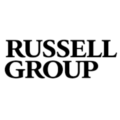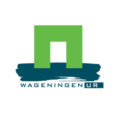Buyer's Guide to Room Booking Software
A Buyer’s Guide to Room Booking Software
There's a bamboozling amount of choice when it comes to room booking software, making it tough to decide which one's right for your organization. In this buyer's guide, you'll get a list of critical and advanced features to look out for, 5 evaluation questions for vendors and the 6 phases of a successful implementation.

From the humble post-it-note to what we have today, meeting room booking software has been around for a while. Add sleek display panels, rooms named after your corporate values and booking directly from your calendar into the mix, and the intense competition and hostility over the best rooms is solved, right?
Not necessarily.
Hybrid threw a spanner in the works because meetings are one of the main reasons people come into the office. You can’t just “grab a meeting room” anymore if everyone else is doing the exact same thing Tuesday to Thursday.
Whether or not your organization’s portfolio size has shrunk over the last few years, hybrid work requires more collaboration spaces than individual desks. And heavy demand for meeting rooms mid-week is a recipe for shortages.
Shortages are no trivial issue when 83% of employees spend up to a third of their week in meetings. 71% of execs surveyed by HBR said meetings are unproductive and inefficient, and 62% said meetings miss opportunities to bring teams closer together.
Unproductive meetings cost $37 billion per year and 75% of employees surveyed by Atlassian said meetings are ineffective for brainstorming.
Those are some pretty damning stats for today’s day and age. And even anecdotally, the number one complaint you hear about the office is the lack of meetings rooms and spaces to take calls.
Sure, there’s more variables at play than the software you choose to book a room. But the point we’re getting at here is that in order for the office to be the collaboration sensation that everyone wants, every detail from deciding where the meeting happens down to the room layout has to be on point.
The right room booking software makes meetings more accessible, more productive, and has huge knock on effects from there.
So whether your organization has outgrown your old system or you need a way to smooth over weekly office occupancy, here are the features to look out for, questions to ask and 5 evaluation criteria if you’re looking for room booking software.
Why Be Choosy with Meeting Room Booking Software?
More often than not, the environment dictates the outcome. Collaborative work is no different.
This study found that in-person vs virtual conferences have different impacts on formal vs informal team bonding. So it’s not a long shot to speculate that the way meeting rooms are designed and meetings are booked influence collaboration effectiveness.
This study finds that informal vs formal meeting room design impacts the outcome of the meeting, stressing the case for space-specific booking software.
The environment meetings are held in isn’t the only factor that makes them a success, but it has an undeniable impact. Especially now that requirements have shifted from needing a room to needing the right type of room.
What categories contribute to the right type of meeting room?
- Size
- A/V equipment
- How formal/informal the space is (mahogany table or bean bag chairs?)
- Room privacy
The room booking software your organization chooses determines how quickly people can find the best rooms for whatever’s on their agenda. And the best rooms are always in demand.
So the right meeting room booking system will:
- Match people with the right room
- Not be a hassle to use (this is the biggest reason systems aren’t adopted and/or fail)
- Give workplace leaders some data about how people are using rooms
- Evolve with how people collaborate in the future
On a broader scale, a room booking system is one of the many workplace systems that contribute to overall workplace experience – in other words, people’s perception of the interactions they have with their company’s digital and physical workplace.
What is Workplace Experience? A Guide for Hybrid Workplaces
Just another HR buzzword? Nope. Read on to clear up the confusion and learn 3 ways to improve your workplace experience.

At the end of the day, the right meeting room booking system means better meetings, which means a better workplace experience.
Room Booking Software Features to Look For
Now that we’ve established why the stakes are higher, here are some of the features that help people find the best collaboration spaces and have better meetings.
✅Visual room selection
Most people want to visualize where their meeting room is and what it looks like, so interactive floor plans are essential when you’re trying to match the right space to the right meeting type.
Look for systems that show you the actual layout, capacity, setup, services and amenities of each room. If someone needs a casual brainstorming space, they shouldn’t have to guess whether Meeting Room C has a formal boardroom table or collaborative seating.
✅Real-time people availability
Figuring out who’s in and the office and who’s wfh while booking a meeting requires some intense mental gymnastics. So the right system will spare people the mental load and integrate calendar data, so you can see if your meeting attendees are even in the office before you book that conference room.
True real-time availability means the system knows how many people will be physically present in a room and how many will be dialing in remotely. Better yet, the system can even suggest a room of the right size with the right A/V equipment depending on the status of each participant
✅Mobile-first design
A good chunk of meetings happen on the same day – for example, when coworkers find each other in the office when they weren’t expecting to. Your booking system needs to match people with the best room on the fly and keep everything in sync. This means seamless booking from whatever fits into people’s existing workflows, be that mobile apps, Outlook, web browsers, or workplace experience apps.
Design should prioritize people who are walking around the office looking for space right now, or planning their week from home on Sunday night.
✅Hassle-free check in
Meeting no-shows are productivity killers and trigger collective office rage, but asking people to manually check in is asking for trouble. Smart systems use geofencing and multiple check-in options to automatically confirm attendance while cutting out that extra admin step for employees.
Look for a system that can provide better data about room usage without making people jump through hoops. Look for solutions that offer automatic check-in when you’re near the room or one-tap mobile check-in.
✅Display panel integration
We’ve all mosied up to a room display panel to sneakily check if it’s free. The best systems let people book directly from the panel, see real-time availability and get automatic updates when meetings change.
The display should reflect the same information people see on their phones and computers. Nothing kills adoption faster than conflicting information across different touchpoints.
✅Accessibility
This one’s non-negotiable but often overlooked. Is the system WCAG 2.1 AA compliant?
WCAG stands for Web Content Accessibility Guidelines, and AA compliance means the software meets international standards for accessibility. Basically, it works for people who use screen readers, can’t use a mouse or have vision impairments or other disabilities. Your booking software should make the office more accessible for people with disabilities, not create additional barriers.
Look for features like screen reader compatibility, keyboard navigation, high contrast modes, and clear visual indicators. If your booking system isn’t accessible, you’re both excluding employees and creating compliance issues.
✅Room usage analytics
A key feature of the right room booking software is the workplace data it gives you, the workplace leader. Can the system tell you:
- Which rooms are consistently booked but rarely used
- Which spaces are in highest demand
- How booking patterns change throughout the week
Look for platforms that help you measure reservations vs actual attendance, identify redesign opportunities and provide insights around how people are collaborating. More on this later!
[Guide] Essential Workplace Metrics
Download this practical toolkit for workplace leaders for 5 metrics to start measuring ASAP.
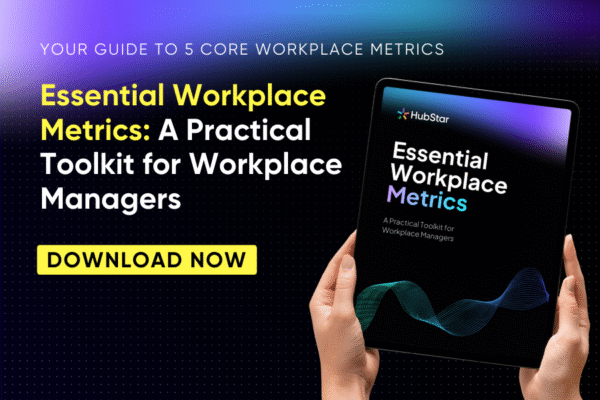
Room Booking & Workplace Tech Integrations
Your meeting room booking system shouldn’t exist in isolation. The best solutions connect with the broader ecosystem of workplace technology, making the entire office experience smoother for employees and more efficient for operations teams. Here are six integration areas to keep in mind when exploring tools.
1) Team Coordination
What it does: Helps teams coordinate their office days and book spaces near each other, showing where teammates are planning to be and suggesting nearby available spaces.
Why it’s important: Eliminates the need to play phone tag to figure out who’s coming in when, and automatically surfaces booking options that keep teams physically close for better collaboration opportunities.
2) Facilities Management and Services
What it does: Integrates with FM backend systems that automatically trigger cleaning, room reconfiguration, catering and more.
Why it’s important: Resources get deployed only where they’re actually needed, and larger meetings with external guests can automatically trigger enhanced cleaning or room setup services. This can make a huge dent in wasted resources, energy, and carbon emissions.
3) Building Management Systems
What it does: Integrates with Building management systems that adjusts HVAC based on actual bookings.
Why it’s important: Heating and cooling systems respond to real demand instead of conditioning empty rooms, with automatic adjustments based on when spaces are actually reserved and occupied. This reduces energy costs while ensuring spaces are comfortable exactly when people arrive.
4) Smart Building Amenities
What it does: Integrates with other systems for amenities like lockers, catering services, bicycle racks, and car parking systems and lets employees reserve everything they need for their day in one place.
Why it’s important: Eliminates the need to use multiple apps or systems to coordinate different aspects of an office visit. Integrating with amenities slashes annoying extra admin for hybrid employees and makes a day in the office feel much more coordinated.
5) Personalizing office visits
What it does: The booking system learns from individual patterns and preferences to match employees with better rooms each time they book.
Why it’s important: The system gets smarter over time, automatically highlighting rooms with whiteboards for people who always brainstorm, or tech-enabled spaces for those who regularly present. This saves time and boosts adoption rates of the system, since it actually supports people’s workplace and meeting requirements.
6) API Infrastructure
What it does: Allows the booking system to both receive data from other platforms and trigger actions in external systems via two-way API capabilities.
Why it matters: When someone books a room, the system can automatically generate IT work orders, facilities requests, and catering orders without manual intervention. This eliminates the coordination burden on employees and ensures all the support services needed for successful meetings happen automatically, reducing meeting preparation stress and improving outcomes. If you can connect any other system that runs off an API, the world is your oyster.
Failed Hybrid Policy Guide: From Crisis to Competitive Advantage
Policy failure? All is not lost. Here's what to do if your organization's hybrid work policy fails - why it happens, real-world examples, how to create and implement policies that actually stick, and red flags that a crisis is around the corner.

Advanced Integration Features
Taking it up a notch, here are a couple of more advanced synchronization features to look out for, especially if your organization is enterprise and/or has a larger office portfolio with multiple hybrid work policies.
✅Floor Plan Synchronization
What it does: Automatically syncs with space planning systems, so when an updated floor plan is published, it automatically updates the room booking system in real-time.
Why it matters: When facilities teams publish new floor plans in their space planning software, room availability, layouts, and configurations instantly reflect across the booking platform without any manual intervention from IT or facilities staff. This eliminates booking conflicts when spaces are reconfigured and prevents the frustrating experience of employees selecting rooms that are laid out differently than expected or don’t exist anymore.
🔴Red flag to look out for: Systems requiring manual updates when spaces change. Many hybrid organizations are changing floor plans every week, and not everyone has the AutoCAD skills to make updates. This creates a breeding ground for errors and frustrated employees when the room they select looks nothing like what they find.
✅HR System Integration
What it does: Integrates with Microsoft’s Active Directory and HR platforms like Workday. This connects individual employee hybrid work schedules with booking logic and room availability.
Why it matters: The system automatically understands each employee’s hybrid work schedule, whether that’s three days per week or full-time, and adjusts their booking experience and policy enforcement accordingly. Employees only see booking options that align with their approved work schedule, reducing policy violations and improving compliance tracking.
🔴Red flag to look out for: Generic booking rules that don’t account for personal hybrid schedules or automatically update when HR policies change. This creates compliance headaches and forces employees to work around system limitations.
A Non-Exhaustive list of Integration Requirements
Employee-facing integrations
- Active Directory (AD)
- Single sign on (SSO)
- Outlook versions
- Exchange Calendars
- Teams
Product Integrations
- AutoCAD
- Occupancy sensors
- Business intelligence systems
- Visitor management systems
- Access control
- Hardware like meeting room panel displays
- Work Order/ Service request systems, like catering, cleaning or repairs
- Reporting tools like PowerBI
Workplace Intelligence and Analytics
Your room booking system is one of the richest sources of workplace behavior data in your organization. Remember, the majority of employees spend a third of their week in meetings, and one of the main reasons people come into the office is other people. Every booking, check-in, and space interaction reveals patterns about how your people actually work, collaborate, and use your real estate investment. Ultimately, this helps workplace leaders figure out if the configuration of collaboration spaces is up to snuff or if it needs to be changed.
This data becomes the foundation for a workplace strategy, including optimizing your office portfolio, improving employee experience, and demonstrating the ROI of your workplace investments.
But raw booking data only tells part of the story. The real value comes from systems that combine booking data with wider workplace data, giving you actionable intelligence about your hybrid workplace.
Here are some room booking analytics features to look out for.
Room Usage Analytics vs Booking Data
What it does: Tracks actual room occupancy (e.g. from occupancy sensors) alongside booking data to reveal which types of rooms are over or underused, peak meeting days, and real average meeting lengths.
Why it matters: Comparing bookings with actual room occupancy reveals meeting no-shows and optimization opportunities. Workplace leaders can work with the top no-show offenders to reduce occurrences and free up rooms for people who actually need them. CRE teams can use data to right-size rooms and optimize room mix (e.g. formal or informal spaces) based on actual demand patterns rather than assumptions.
Descriptive Room Usage Insights vs Wider Workplace data
What it does: Consolidates room usage analytics with data from the rest of the workplace. For example, desk booking data and neighborhood occupancy data.
Pro-tip: consolidate all of this into a single dashboard.
Why it matters: Room usage doesn’t happen in a vacuum – it’s part of a wider trend on how people are using the workplace. Facilities and workplace teams can quickly understand what happened over time without needing data science expertise or spending months building reporting infrastructure.
Two Reasons Why Traditional Workplace Metrics Aren't Enough in 2025
The workplace has evolved, but the metrics we use to measure its success haven't - until now. Here's why measuring traditional workplace metrics alone isn't cutting it anymore in 2025.

Predictive Room Usage Insights
What it does: Predicts room usage patterns and trends in your workplace data based on what’s happening now and in the past.
Why it matters: CRE teams can proactively plan collaboration space adjustments. Workplace teams can stay ahead of room capacity issues instead of constantly reacting to booking conflicts.
Prescriptive Room Usage Analytics
What it does: Analyzes room usage predictions and recommends what you should do next, using data patterns to suggest optimal actions for your room and collaboration space portfolio.
Why it matters: The system recommends specific changes like converting a larger board room into two smaller rooms. This saves time, makes conversations with stakeholders easier, and helps you optimize space allocation and improve employee satisfaction through evidence-based changes.
Other things to keep in mind
Dashboards: Standardized dashboards showing concrete metrics like peak room usage, average days in the office per week and policy compliance are absolutely essential. And while it might be tempting to configure your own metrics depending on what the wider business thinks is important, out-of-the-box dashboards save you time because they start measuring as soon as the system is up and running, and standardize the metrics you use to measure room booking success over time.
Employee decision support: when room booking data is consolidated with other employee-facing systems like desk booking and workplace experience apps, machine learning can automate finding the best times to come in and the most effective spaces and rooms to book depending what’s on the agenda. The more people use the system, the smarter it gets, and the easier it becomes to plan a productive day in the office.
Think Desk Booking Is About Booking Desks? Think Again.
It's actually about connection, clarity, and workplace agility. Here's why.

Evaluation Framework: 5 Critical Questions to Ask
So the pedal is down to the metal and you’ve shortlisted some options. When evaluating room booking systems, most organizations focus on features and pricing – and that’s a solid but incomplete approach because the real differentiators emerge when you ask the right questions.
Here are five questions to ask that will help you pinpoint whether a system is right for your organization.
❓Question 1: Does it handle your actual meeting patterns?
Small room availability and booking speed
A booking system needs to handle high-demand, quick-turnaround spaces. Can employees find and book small rooms instantly, or does the system bog down when everyone’s looking for the same four-person spaces on Tuesday morning?
Support for different space types
Studies have shown that creative and technical meetings have distinct atmospheric needs. Your system should categorize spaces beyond just capacity, but by collaborative zones, focus rooms, presentation spaces, phone booths and an infinite level of detail depending on your organization.
Flexible booking rules and policies
How configurable is the rules engine? Can you set different policies for different user groups, locations, or space types? A robust rules engine prevents booking conflicts and helps you adopt the software globally. Roll out different rules and policies in different regions and countries (bonus points for handling multiple languages) boosts user adoption, because no one has to fit their booking behaviour into an uncomfortable new box.
Look for systems that can handle complex scenarios like different maximum booking times by department.
❓Question 2: How does it integrate with your existing tools?
Microsoft ecosystem compatibility
Deep integration means more than just calendar sync. Can users book directly from Outlook or Teams? Does the system gel with existing meeting workflows, or does it force people to learn entirely new processes?
HR system synchronization
Does it connect with Workday, BambooHR, or your existing HR platform? If your organization has hybrid work policies, it will be a huge time saver if the booking system understands individual employee schedules and applies appropriate rules automatically.
Hardware integration capabilities
Does the booking system work seamlessly with room displays, occupancy sensors, access control systems, and AV equipment? Ask vendors to demonstrate these integrations working together, not just show you screenshots.
Data export and reporting options
Can you get your data out easily? Look for systems with two-way APIs and standard export formats. You shouldn’t be locked into proprietary reporting tools that limit your analytical capabilities.
❓Question 3: What workplace intelligence does it actually provide?
Policy compliance tracking
Can you measure adherence to hybrid work policies? If your organization requires certain office attendance patterns, the system should provide visibility into compliance without being invasive, punitive or feeling big brother-y in any way.
Pro-tip: Non-compliance is a signal to re-evaluate the policy, not slap on even more hard-line mandates.
Actionable insights for space planning
Does the system provide specific recommendations based on your usage patterns, like suggesting which large conference rooms could be converted to smaller spaces based on actual demand? How straightforward is it to generate reports and answer questions for stakeholders who “speak a different language” than workplace and CRE teams (for example, the C Suite and HR)?
Measurable ROI metrics
Metrics that matter vary across organizations depending on objectives, but there are many that should be standard. Space utilization improvements, reduced booking no-shows, employee satisfaction scores, and cost savings from optimized space allocation are just a few.
❓Question 4: Can it scale with your workplace evolution?
Multi-location support and languages
If you have multiple offices or global operations, the system should handle different locations, time zones, and languages without requiring separate instances or complex workarounds.
Dynamic floor plan management
How easily can spaces be reconfigured in the booking system? With hybrid work driving frequent space changes, you need systems that adapt quickly when you move walls or repurpose areas. Manual floor plan updates will become a constant source of frustration for both admins and employees.
Flexible hybrid policies
Can the system support different hybrid work patterns that change frequently? Your booking system should evolve with your workforce policies, not constrain them.
Policy management across regions
Different locations may have different booking rules, compliance requirements, and cultural norms. Look for systems that can accommodate regional variations while maintaining centralized oversight.
[Guide] Dynamic Workplace Strategy: 6 Goals and 4 Capabilities for Success in 2025
Work is change. Download this guide for priorities and tools you'll need to manage constantly changing spaces, people and priorities.
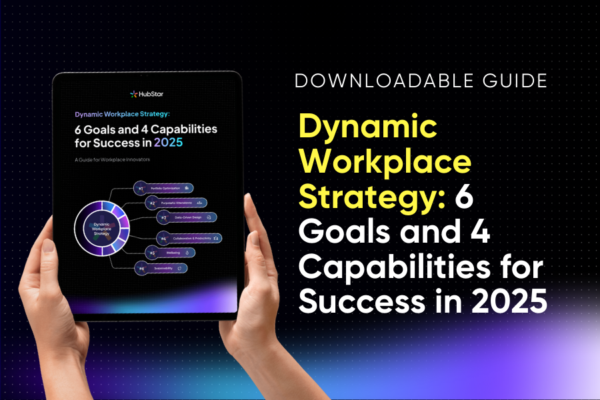
❓Question 5: What’s the true total cost of ownership?
Licensing Models and Hidden Fees
Understand exactly what you’re paying for. Are there per-user fees, per-location charges, or additional costs for integrations? Some vendors quote attractive base prices but add significant fees for essential features.
Implementation and Training Costs
Factor in the time and resources needed to get the system running effectively. Complex systems with poor user experience will require extensive training and change management – costs that often exceed the software licensing fees. What happens after the initial database is configured? How does the handoff work between implementation and customer success management?
Ongoing Maintenance and Support
What level of support is included? How are updates and new features delivered? Systems that require significant IT resources for maintenance and updates can become expensive quickly, especially if your team lacks specialized expertise.
5 Phases of Room Booking Software Implementation
So it’s time to implement the room booking software you’ve chosen. But implementation is where good intentions meet harsh reality.
70% of change management initiatives fail, and workplace technology rollouts are no exception. The difference between success and failure often comes down to choosing a vendor who understands that software adoption is about people, not technology.
Look for vendors with an implementation methodology that addresses the human side of workplace change. Even the most intuitive system will get tossed to the wayside if employees don’t understand why they should care or how it improves their work experience.
Here are the five phases of a successful software implementation, and questions to ask vendors about each phase.
Phase 1: Strategy & Planning
Define the Why
Set your vision for the project by asking some soul searching questions. Why should people care about this? What is leadership’s vision for how people use the workplace? What level of autonomy and flexibility do you want to offer employees? Without clear answers, your implementation becomes a technology exercise rather than a workplace transformation.
Question to ask vendors: “How do you help organizations define their workplace vision and translate it into system requirements?”
Identify Hybrid Work Patterns
Map out the different hybrid work personas across your organization, for example: three days in-office, full-time, remote, only show up when there’s a company all-hands and so on. Identifying employees with different workplace and accessibility needs is critical here too. Understanding these patterns upfront prevents configuration headaches later and ensures the system supports actual work patterns rather than theoretical policies.
Question to ask vendors: “What process do you use to identify and map different employee work patterns during implementation?”
Assess Current Challenges
What hybrid work strategy challenges are you trying to solve? Are there upcoming changes to portfolio size, policies, or culture that could impact how people collaborate? The implementation should address real problems, not just digitize existing processes.
Question to ask vendors: “How do you assess current workplace challenges and ensure the solution addresses real business problems?”
Phase 2: Configure for Modern Meeting Behaviors
Set Up Visual Floor Plans
Configure interactive floor plans with real-time synchronization to your space planning systems.
Question to ask vendors: “What’s your process for setting up and maintaining visual floor plans that sync with our space planning systems?”
Configure Hybrid Personas
Set up different user profiles according to the personas you identified in the previous step. The system should understand individual work patterns and apply appropriate booking rules automatically.
Question to ask vendors: “How do you configure different user personas and ensure the system applies the right rules to each employee type?”
Establish Aligned Booking Rules
Create booking policies that align with individual work schedules and organizational goals. This includes everything from booking time limits to advance reservation windows, tailored to different user groups, space types, locations, regions and countries.
Question to ask vendors: “How flexible is your rules engine, and what support do you provide for configuring complex booking policies?”
Phase 3: Launch & Training
Streamlined User Training
Roll out training with FAQs, pre-recorded demos, and day-in-the-life scenarios.
Pro-tip: if your solution requires extensive end-user training, it’s probably not intuitive enough. Focus training efforts on administrators who need to configure booking rules and manage the system.
Question to ask vendors: “What training materials and support do you provide, and how much training should end-users realistically need?”
Admin Enablement
Ensure your facilities and IT teams understand how to configure booking rules, manage floor plans, and troubleshoot common issues. This is where comprehensive training becomes critical, because admins need deep system knowledge to support users effectively when hybrid workplace change moves at a mile a minute.
Question to ask vendors: “What ongoing training and certification do you provide for system administrators?”
Phase 4: Change Management
Communicate the Why
Design a communication plan with leadership endorsement, multi-channel messaging, and visual teasers that clearly explain what employees gain from the new system. People need to understand how this makes their work life better, not just different.
Question to ask vendors: “What change management resources and templates do you provide to help communicate the value to employees?”
Leadership Alignment
Ensure leaders are talking the talk and walking the walk. If someone finds an executive in an un-booked room, change management initiatives go out the window. Leadership behavior sets the tone for organization-wide adoption.
Question to ask vendors: “How do you help ensure leadership alignment and model the behaviors needed for successful adoption?”
Feedback-Driven Adoption
Boost adoption with active feedback channels, phased rollouts or pilots, and quick fixes based on user input. The fastest way to kill adoption is ignoring early user feedback or being slow to address obvious problems.
Question to ask vendors: “What’s your process for collecting and acting on user feedback during the rollout phase?”
Phase 5: Continuous Measuring & Optimizing
Policy Metrics Analysis
Regularly analyze compliance metrics and adjust policies as needed. The goal isn’t perfect compliance, but finding the right balance between organizational needs and employee flexibility.
Question to ask vendors: “What out-of-the-box metrics and dashboards do you provide after go-live?”
Success Story Communication
Share concrete examples of how the system is improving workplace experiences, reducing booking conflicts, or enabling better collaboration. Data-driven success stories build momentum for continued adoption.
Question to ask vendors: “How do you help organizations measure and communicate success stories to achieve high adoption rates?”
Ongoing Leadership Engagement
Maintain leadership visibility and engagement beyond the initial launch. Workplace technology adoption is an infinity loop of measuring, tweaking and communicating.
Question to ask vendors: “What long-term support do you provide to maintain leadership engagement and system optimization?”
The vendors who can answer these questions with specific examples and proven methodologies are the ones who understand that successful room booking software implementation is as much about psychology as it is about technology.
[Guide] Leading Dynamic Workplace Change: 10 Human-Centered Principles
Download this guide to explore why traditional change management usually fails, 10 actionable change management principles and how to create the right conditions for lasting change.
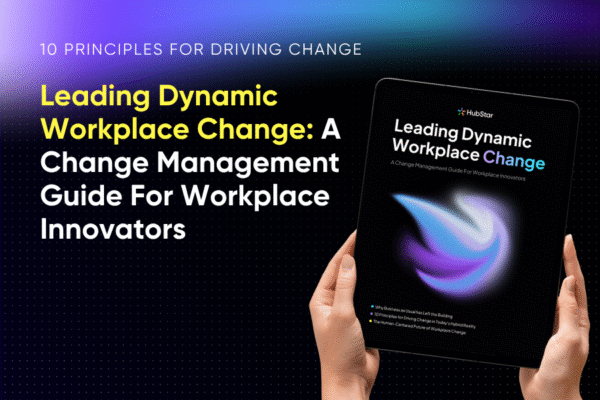
How to Measure Room Booking Software Success
The true value of room booking software extends far beyond cutting back on employee complaints. The most successful implementations focus on metrics that demonstrate improved workplace effectiveness, employee satisfaction, and strategic decision-making capabilities.
It can take a while to measure each of these, but here are some solid metrics to keep in mind.
Space utilization metrics
- Booking vs. occupancy rates
- Room type preferences
- Peak usage analysis
Employee experience indicators
- Satisfaction and adoption rates
- Booking no-show rate changes
- Change in retention rates
Operational efficiency metrics
- Policy compliance rates
- Meeting pattern insights
Strategic insights
- Actual vs planned meeting attendance
- Space optimization opportunities
- Hybrid policy optimization opportunities
When your room booking system delivers insights that drive better workplace decisions, the ROI extends far beyond the software investment to impact your entire real estate and workplace strategy.
Ready to see room booking done right?
HubStar Connect's room booking software gives you a system so intuitive employees don't need training, advanced workplace analytics out of the box, and a partnership that goes far beyond deployment.

Share this post












